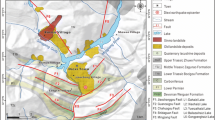Abstract
A large rock avalanche fell from the slope below Hillary Ridge of Aoraki/Mount Cook at 21:32 (New Zealand Standard Time (NZST) = UTC + 12 h) on Monday 14 July 2014. About 0.9 million m3 of indurated greywacke collapsed from a >60° slope at 43.6165°S 170.1427°E between 2600 and 2920 m, without warning or apparent trigger. The avalanche of rock debris crossed Noeline Glacier névé, entraining snow and ice debris, before passing through an icefall, accelerating down steepening slopes and ended on Hooker Glacier. A small mountaineering shelter sited on a topographic high within the avalanche path was damaged but not completely destroyed. Covering a total fall of 1600 m and travel distance of 3.9 km, the avalanche angle of reach was 24°. The deposit of rock, snow and ice debris covers 1.4 million m2. Airborne dust travelled at least 6 km. The event was recorded by the national seismograph network, as a ML2.6 earthquake with the strongly emergent characteristics of a large avalanche.









Similar content being viewed by others
References
Allen SK, Huggel C (2013) Extremely warm temperatures as potential cause of recent high mountain rockfall. Glob Planet Chang 107:59–69
Allen SK, Gruber S & Owens IF (2009) Exploring steep bedrock permafrost and its relationship with recent slope failures in the Southern Alps of New Zealand. Permafrost and Glacial Processes. Published online in Wiley InterScience doi: 10.1002/ppp.658
Allen SK, Cox SC, Owens IF (2011) Rock avalanches and other landslides in the central Southern Alps of New Zealand: a regional study considering potential climate change impacts. Landslides 8:33–48
Barff E (1873) A letter respecting the recent change in the apex of Mount Cook communicated by J. Hector. Trans Proc N Z Inst 6:379–380
Berryman KR, Cochran UA, Clark KJ, Biasi GP, Langridge RM & Villamor P (2012) Major earthquakes occur regularly on an isolated plate boundary fault. Science, 336, 1690–1693; doi: 1610.1126/science.1218959
Boese C, Jacobs K, Smith EGC, Stern TA, Townend J (2014) Background and delayed-triggered swarms in the central Southern Alps, South Island, New Zealand. Geochem Geophys Geosyst 15(4):945–964. doi:10.1002/2013GC005171
Columbus J, Sirguey P, Tenzer R (2011) A free, fully assessed 15-m DEM for New Zealand. Surv Q 66:16–19
Cox SC, Allen SK (2009) Vampire rock avalanches of January 2008 and 2003, Southern Alps, New Zealand. Landslides 6:161–166. doi:10.1007/s10346-009-0149-4
Cox SC, Barrell DJA (2007) Geology of the Aoraki Area, New Zealand. Institute of Geological and Nuclear Sciences 1:250,000 geological map 15. 1 sheet + 71 p. Lower Hutt, New Zealand. GNS Science
Cox SC, Findlay RH (1995) The Main Divide Fault Zone and its role in formation of the Southern Alps, New Zealand. N Z J Geol Geophys 38(4):489–499
Cox SC, Sutherland R (2007) Regional geological framework of South Island, New Zealand, and its significance for understanding the active plate boundary. In: Okaya DA, Stern TA, Davey FJ (eds) (2007) A continental plate boundary: tectonics at South Island, New Zealand. Washington, DC: American Geophysical Union. Geophysical Monograph. 175: 19–46
Cox SC, Stirling MW, Herman F, Gerstenberger M & Ristau J (2012) Potentially active faults in the rapidly eroding landscape adjacent to the Alpine Fault, central Southern Alps, New Zealand. Tectonics, 31, TC2011. Doi:2010.1029/2011TC003038 (003024 p.)
Cox SC, Menzies CD, Sutherland R, Denys PH, Chamberlain C, Teagle DAH (2015) Changes in hot spring temperature and hydrogeology of the Alpine Fault hanging wall, New Zealand, induced by distal South Island earthquakes. Geofluids, Online First. DOI: 10.1111/gfl.12093.
Hancox GT, Thomson R 2013 The January 2013 Mt Haast Rock Avalanche and Ball Ridge Rock Fall in Aoraki/Mt Cook National Park, New Zealand. GNS Science Report 2013/33. 31 p. Available from http://info.geonet.org.nz/download/attachments/2196288/SR2013-033_Mt_Haast_Rock_Avalanche.pdf?api=v2
McSaveney MJ (2002) Recent rock falls and rock avalanches in Mount Cook National Park, New Zealand. Geol Soc Am Rev Eng Geol XV:35–70
McSaveney MJ, Cox SC, Hancox GT (2014) Seeking a credible cause of the recent increase in rock-avalanche frequency in New Zealand’s Southern Alps. Abstract. Paper 14453 submitted for American Geophysical Union Fall Meeting, San Francisco, 15–19 December 2014
Sirguey P (2014) The recent survey of Aoraki/Mt Cook. Quarterly Magazine of the Association of Consulting Surveyors (NSW), March: 6–7
Whitehouse IE (1983) Distribution of large rock avalanche deposits in the central Southern Alps, New Zealand. N Z J Geol Geophys 26(3):271–279
Whitehouse IE, Griffiths GA (1983) Frequency and hazard of large rock avalanches in the central Southern Alps, New Zealand. Geology 11:331–334
Acknowledgments
The authors thank Jim Campbell (Helicopter Line Mount Cook), Department of Conservation (Mike Davies, Dave Dittmer and Don Bogie), Geoff Clitheroe, Sally Dellow, Bill Fry, Santanu Misra and Belinda Smith-Lyttle (GNS Science). Air temperature and rainfall data were provided by the National Institute of Water and Atmospheric Sciences (NIWA) though the climate database (http://cliflo.niwa.co.nz). The majority of the work was funded and has been released by Department of Conservation, supplemented through the New Zealand GeoNet project (http://www.geonet.org.nz/) immediate response function fulfilled by GNS Science, and by the Hazard Platform. Thoughtful comments and suggestions were provided by Simon Loew (associate editor), Alexander Strom and two anonymous reviewers.
Author information
Authors and Affiliations
Corresponding author
Rights and permissions
About this article
Cite this article
Cox, S.C., McSaveney, M.J., Spencer, J. et al. Rock avalanche on 14 July 2014 from Hillary Ridge, Aoraki/Mount Cook, New Zealand. Landslides 12, 395–402 (2015). https://doi.org/10.1007/s10346-015-0556-7
Received:
Accepted:
Published:
Issue Date:
DOI: https://doi.org/10.1007/s10346-015-0556-7




